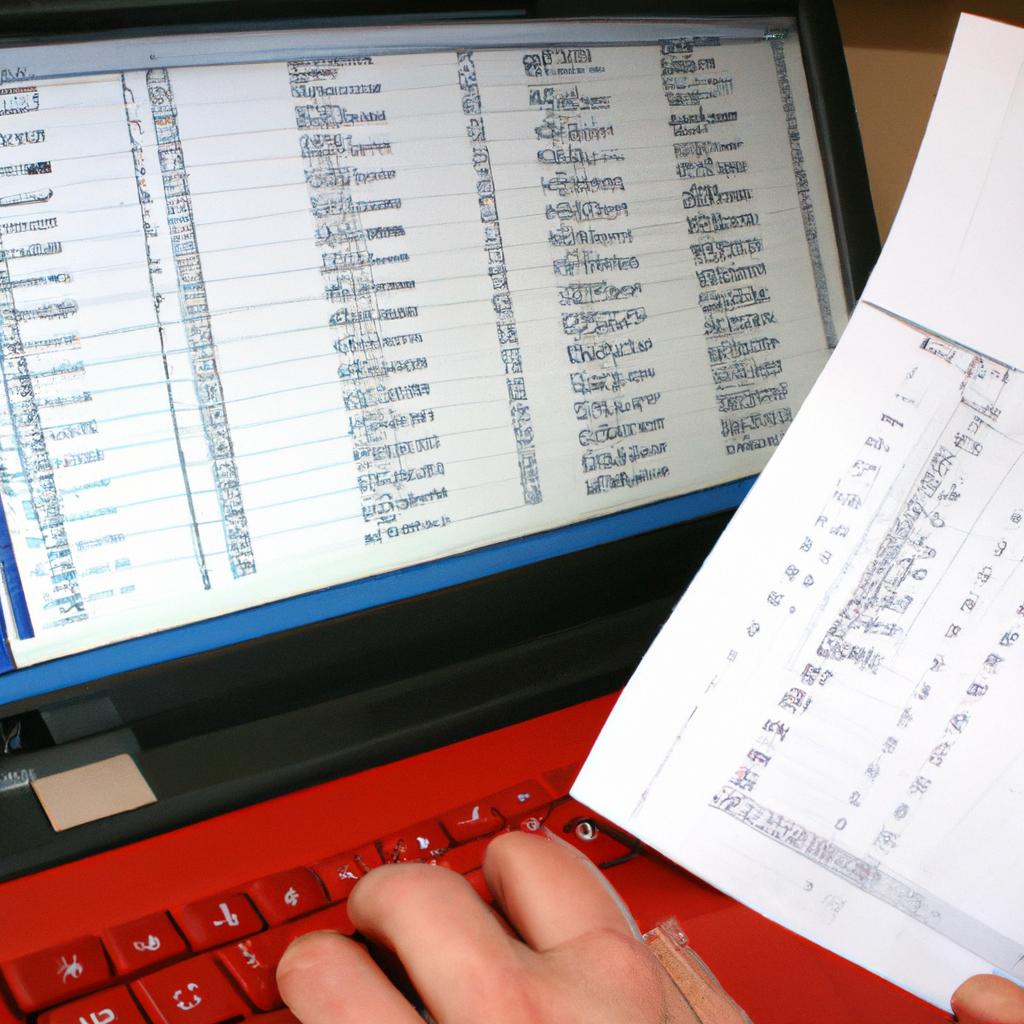Bank Reconciliation: Streamlining Tax Preparation with Accounting Software

Bank reconciliation is an essential process in accounting that ensures the accuracy and completeness of financial records. It involves comparing a company’s internal records with its bank statement to identify any discrepancies and reconcile them accordingly. With the advancement in technology, accounting software has become a valuable tool for streamlining this process, particularly when it comes to tax preparation. For instance, consider a hypothetical case study of XYZ Company, which faced numerous challenges during tax season due to manual bank reconciliation processes. This article examines how the implementation of accounting software can simplify and expedite the bank reconciliation process, ultimately leading to more efficient tax preparation.
In today’s fast-paced business environment, efficiency and accuracy are paramount in managing financial transactions and complying with taxation regulations. Traditional methods of bank reconciliation often involve labor-intensive tasks such as manually comparing data from various sources, tracking down errors or missing entries, and then documenting these findings on paper or spreadsheets. These practices not only consume significant time but also increase the likelihood of human error. However, by utilizing advanced accounting software like QuickBooks or Xero, companies can automate many aspects of the bank reconciliation process. This automation allows businesses to import bank statements directly into their accounting system, automatically match transactions with corresponding entries in their internal records, and generate reports that clearly show any discrepancies between the two sets of data.
One significant advantage of using accounting software for bank reconciliation is the ability to streamline and expedite the process. With manual methods, it can be time-consuming to gather all the necessary information and manually compare each transaction. However, accounting software automates this process by importing bank statements directly into the system. The software then matches transactions based on criteria such as date, amount, or description, reducing the need for manual intervention. This automation not only saves time but also minimizes the risk of errors that may occur during manual data entry.
Another benefit of using accounting software is improved accuracy. Manual bank reconciliations are prone to errors due to human oversight or incorrect calculations. By utilizing accounting software, businesses can ensure that every transaction is accurately recorded and matched with corresponding entries in their internal records. The software’s algorithms and built-in checks help identify discrepancies between the bank statement and internal records, making it easier to locate errors or missing transactions.
Additionally, accounting software provides real-time visibility into a company’s financial position. By automatically updating transactions from bank statements into the system, businesses can have an up-to-date view of their cash flow and account balances at any given moment. This real-time visibility allows companies to make informed decisions regarding their finances and facilitates better tax planning and preparation.
Moreover, using accounting software simplifies record-keeping and documentation. Instead of maintaining piles of paper documents or numerous spreadsheets, all financial data is stored electronically within the system. This not only reduces clutter but also makes it easier to retrieve information when needed for audits or compliance purposes.
In conclusion, implementing accounting software for bank reconciliation can greatly simplify and expedite the process while ensuring accuracy in financial records. By automating tasks that were previously done manually, businesses can save time, minimize errors, enhance visibility into financial positions, and streamline tax preparation processes. As technology continues to advance in the field of accounting, leveraging accounting software for bank reconciliation is becoming an essential practice for businesses to stay efficient and compliant.
Understanding Bank Reconciliation
Bank reconciliation is a crucial process in accounting that ensures the accuracy and reliability of financial records. It involves comparing an organization’s internal records with its bank statement to identify any discrepancies and reconcile them. By doing so, businesses can maintain accurate financial statements and streamline their tax preparation.
To illustrate the importance of bank reconciliation, let’s consider a hypothetical case study. Imagine a small business owner named Sarah who runs a retail store. She diligently keeps track of her company’s transactions using accounting software but occasionally encounters discrepancies between her own records and the bank statement. These differences could arise due to various reasons such as outstanding checks, deposits in transit, or bank errors.
One primary purpose of bank reconciliation is to detect errors or fraudulent activities promptly. Utilizing advanced accounting software enables organizations like Sarah’s retail store to automate this process efficiently, saving time and reducing the risk of human error. The benefits of implementing accounting software for streamlining bank reconciliation include:
- Increased Accuracy: Automation eliminates manual data entry errors, ensuring precise matching of transactions.
- Time Efficiency: Software automatically compares thousands of transactions within seconds, freeing up valuable time for other critical tasks.
- Fraud Detection: Automated systems can flag suspicious transactions or irregular patterns that may indicate fraudulent activity.
- Financial Insights: Detailed reports generated by accounting software provide valuable insights into cash flow management and budgeting.
| Benefits of Accounting Software for Bank Reconciliation |
|---|
| Increased Accuracy |
| Time Efficiency |
| Fraud Detection |
| Financial Insights |
In conclusion, understanding bank reconciliation is vital for maintaining accurate financial records and optimizing tax preparation processes. Through automation provided by modern accounting software, businesses can ensure precision, save time, detect fraud effectively, and gain valuable financial insights from reconciled information. In the following section, we will delve deeper into why this process holds significant importance in organizational finance management—the importance of bank reconciliation.
[Transition Sentence] Now that we have explored the fundamentals of bank reconciliation, let us examine why this process holds significant importance in organizational finance management.
The Importance of Bank Reconciliation
Streamlining Tax Preparation with Accounting Software: The Role of Bank Reconciliation
Imagine a small business owner named Sarah who is preparing her tax returns. She diligently gathers all the necessary financial documents, including bank statements and receipts, to ensure accurate reporting. However, as she compares her records to the bank statement, she notices discrepancies between her own records and those of the bank. This situation highlights the importance of performing regular bank reconciliation, a process that ensures consistency between a company’s internal records and its financial institution’s information.
Bank reconciliation serves as a vital tool for businesses in managing their finances effectively. By comparing transactions recorded in an accounting software system with those provided by the bank, it allows for identification and resolution of any discrepancies or errors promptly. This process helps maintain accurate financial records, minimizing potential mistakes or fraudulent activities while providing an auditable trail of transactions.
To illustrate further why bank reconciliation is crucial for businesses, consider these key points:
- Accuracy: Regularly reconciling accounts provides assurance that financial data entered into the accounting software matches actual banking activity.
- Fraud detection: Identifying unusual transactions during bank reconciliation can help detect possible fraudulent activities such as unauthorized withdrawals or forged checks.
- Financial analysis: Bank reconciliation enables more effective financial analysis by ensuring accurate cash flow monitoring and identifying trends or patterns related to income and expenses.
- Decision-making support: Accurate financial data resulting from thorough bank reconciliation facilitates informed decision-making regarding budgeting, investments, operational improvements, and other strategic initiatives.
| Benefits of Performing Bank Reconciliation | Emotional Response |
|---|---|
| Ensures accuracy in financial records | Confidence |
| Detects potential fraud | Security |
| Facilitates effective financial analysis | Insight |
| Supports informed decision making | Empowerment |
By investing time and effort into conducting regular bank reconciliations using appropriate accounting software tools, businesses like Sarah’s can streamline their tax preparation process. The next section will explore in further detail the benefits of utilizing accounting software for bank reconciliation, providing an insight into how it can enhance financial management practices and improve overall operational efficiency.
Benefits of Using Accounting Software
Bank reconciliation is a critical process for any business, as it ensures that the company’s records match the transactions recorded in its bank statements. By comparing these two sets of data, discrepancies can be identified and resolved promptly. In today’s digital age, accounting software has revolutionized this process by automating many of the tasks involved in bank reconciliation.
For instance, let us consider a hypothetical case study of a small retail business. Prior to using accounting software, the owner would manually reconcile their bank accounts at the end of each month. This laborious task required matching hundreds of transactions from various sources such as credit card payments, cash deposits, and electronic transfers. The risk of errors was high due to manual entry and limited visibility into transaction details.
However, with the implementation of accounting software specifically designed for bank reconciliation purposes, this small retail business experienced several benefits:
- Time-saving: With automation features like importing bank statements directly into the software and categorizing transactions automatically, valuable time previously spent on manual data entry could now be allocated towards more strategic activities.
- Improved accuracy: Accounting software reduces human error associated with manual reconciliations by eliminating the need for repetitive data input and providing real-time updates on account balances.
- Enhanced analysis: Advanced reporting capabilities allow businesses to gain insights into spending patterns, identify discrepancies quickly, and make informed decisions based on accurate financial information.
- Increased security: Robust encryption protocols protect sensitive financial data stored within the software, ensuring compliance with privacy regulations and minimizing risks related to unauthorized access or loss of physical documents.
To further illustrate these benefits in an engaging manner, imagine a comparison table showcasing how traditional manual bank reconciliation measures up against utilizing accounting software:
| Traditional Bank Reconciliation | Automated Bank Reconciliation (with Accounting Software) |
|---|---|
| Time-consuming | Time-saving |
| Prone to errors | Improved accuracy |
| Limited visibility | Enhanced analysis |
| Security risks | Increased security |
By implementing accounting software, businesses can streamline their bank reconciliation process and enjoy the advantages it brings.
Streamlining the Reconciliation Process
When it comes to bank reconciliation, using accounting software can significantly streamline the process and enhance the overall efficiency of tax preparation. Let’s consider a hypothetical example to illustrate this point: Imagine a small business owner who manually reconciles their bank statements every month. This task involves comparing transaction records from their business account with those provided by the bank, identifying discrepancies, and making adjustments accordingly. However, without the aid of technology, this process can be time-consuming and prone to errors.
By leveraging accounting software specifically designed for bank reconciliation purposes, businesses can enjoy several benefits that simplify and expedite this crucial financial task:
-
Automation: One significant advantage of utilizing accounting software is automation. With just a few clicks, transactions recorded in the system are matched against entries on bank statements. The software quickly identifies any disparities or missing information, reducing human error while saving considerable time.
-
Real-time updates: Accounting software provides real-time access to updated banking data. It automatically imports electronic statements and allows users to reconcile them promptly. This feature ensures accuracy as well as enables timely identification of any fraudulent activities or unauthorized transactions.
-
Error detection: Alongside automating the reconciliation process, accounting software also includes built-in error detection mechanisms. These tools alert users when duplicate entries or inconsistencies are found within the transaction history, minimizing mistakes before they become more challenging to rectify.
-
Reporting capabilities: Most modern accounting software offers comprehensive reporting features that allow users to generate detailed reconciliation reports effortlessly. These reports provide insights into cash flow management and help identify potential areas of improvement in terms of financial performance.
To better understand how adopting accounting software can benefit businesses during the reconciliation process, refer to Table 1 below:
| Benefits | Description |
|---|---|
| Time-saving | Eliminates manual effort involved in matching transactions |
| Accuracy | Minimizes human errors through automated checks |
| Fraud detection | Enables prompt identification of unauthorized transactions |
| Financial insights | Provides detailed reports for better decision-making |
In conclusion, utilizing accounting software significantly streamlines the bank reconciliation process. By automating tasks, providing real-time updates, detecting errors, and offering robust reporting capabilities, businesses can save time, improve accuracy, enhance fraud detection mechanisms, and gain valuable financial insights.
Moving forward to the next section on “Enhancing Accuracy and Efficiency,” let us explore additional measures that further optimize the use of accounting software in tax preparation.
Enhancing Accuracy and Efficiency
With the ever-increasing need for accuracy and efficiency in financial management, many businesses are turning to accounting software solutions to streamline their bank reconciliation process. This section explores how automated bank reconciliation can enhance accuracy and efficiency, ultimately aiding tax preparation.
Consider a hypothetical case study of XYZ Company, which used manual methods for bank reconciliation until recently. The company often faced challenges with matching transactions, resulting in time-consuming efforts to identify discrepancies. However, after implementing accounting software that automates the bank reconciliation process, XYZ Company experienced significant improvements in both accuracy and efficiency.
Automated bank reconciliation offers several benefits over traditional manual methods:
- Time-saving: By automatically importing and matching transactions from multiple sources, such as banks and credit card statements, accounting software reduces the time spent on data entry and verification.
- Error reduction: With built-in algorithms and cross-referencing capabilities, automated systems minimize human errors associated with manual data input or calculation mistakes.
- Enhanced visibility: Accounting software provides real-time access to financial information, allowing businesses to monitor cash flow more effectively and detect potential issues promptly.
- Seamless collaboration: Cloud-based platforms enable multiple users to work simultaneously on reconciliations from different locations, fostering collaboration among team members.
To highlight the advantages further, consider the following comparison table showcasing key differences between manual and automated bank reconciliation:
| Manual Bank Reconciliation | Automated Bank Reconciliation | |
|---|---|---|
| Time | Hours or days | Minutes |
| Accuracy | Prone to errors | High level of accuracy |
| Accessibility | Limited by physical files | Real-time access |
| Scalability | Challenging | Easily scalable |
By embracing automated bank reconciliation processes offered by accounting software solutions, organizations like XYZ Company have witnessed improved financial oversight. As a result, they can now allocate valuable resources towards more strategic financial planning and decision-making.
Transitioning into the subsequent section on “Tips for Effective Bank Reconciliation,” businesses can further optimize their reconciliation process by following a few key principles.
Tips for Effective Bank Reconciliation
Building upon the importance of enhancing accuracy and efficiency in bank reconciliation, let us now explore some valuable tips that can help ensure a smooth process. By following these guidelines, businesses can optimize their tax preparation efforts while leveraging the advantages provided by accounting software.
Tips for Effective Bank Reconciliation:
-
Maintain up-to-date records:
- Regularly update transaction data in your accounting software.
- Ensure all deposits, withdrawals, and transfers are accurately recorded.
- Include essential details such as dates, descriptions, and categories to facilitate easy identification during reconciliation.
-
Perform regular reconciliations:
- Schedule frequent reconciliations between your bank statement and accounting records.
- This helps identify discrepancies promptly and reduces the chances of errors going unnoticed.
- Consider conducting monthly or quarterly reconciliations depending on the volume of transactions.
-
Utilize automated matching features:
- Take advantage of advanced accounting software’s automation capabilities.
- Match incoming and outgoing transactions automatically to reduce manual effort and enhance accuracy.
- Automated matching flags any discrepancies for further investigation, saving you time and minimizing potential mistakes.
- Peace of mind: Accurate bank reconciliations provide reassurance when it comes to financial integrity.
- Time savings: Automation streamlines the process, freeing up resources for other business-critical tasks.
- Improved decision-making: Real-time insights gained through effective reconciliation allow informed financial decisions.
- Compliance readiness: Properly reconciled accounts ensure smoother audits and compliance with regulatory requirements.
Table showcasing benefits (Markdown format):
| Benefit | Description |
|---|---|
| Peace of mind | Accurate bank reconciliations provide reassurance when it comes to financial integrity. |
| Time savings | Automation streamlines the process, freeing up resources for other business-critical tasks. |
| Improved decision-making | Real-time insights gained through effective reconciliation allow informed financial decisions. |
| Compliance readiness | Properly reconciled accounts ensure smoother audits and compliance with regulatory requirements. |
Incorporating these tips into your bank reconciliation process can significantly streamline tax preparation efforts while leveraging the capabilities of accounting software.
Remember, consistency is key in maintaining accurate records and conducting regular reconciliations. By utilizing automated matching features, businesses can optimize their time and minimize errors during the reconciliation process.
Efficient bank reconciliation not only ensures accuracy but also provides peace of mind, saves valuable time, enables better decision-making, and positions businesses well for audit readiness. Embrace these best practices to enhance your company’s financial management processes and maximize productivity.




